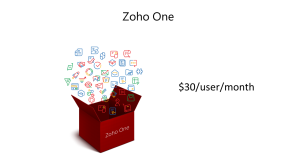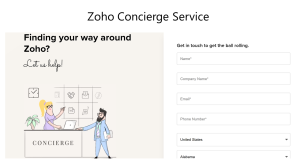Until recently, Zoho’s focus been on the small business market, which now accounts for more than 80% of its customers. But over the past couple of years, Zoho has launched a concentrated campaign to win business in larger accounts.
All too often, once vendors go upmarket, they slowly but surely lose focus on the small businesses that “brung ‘em” to the dance in the first place. However, as I learned at Zoho’s January analyst event (#ZohoDay2020), Zoho remains intensely committed to small business, and is formulating some very big plans that convince me that it will not take its eye off the small business ball.
A (Very) Brief History of Zoho
I’ve blogged about Zoho numerous times over the years—most recently here, here and here.
If you’re not familiar with Zoho, however, I’m not surprised. Zoho has spent much of its 20-year history as one of the best-kept secrets in the industry. But. during that time, Zoho has quietly grown from being a software-as-a-service (SaaS) vendor offering a handful of applications into a technology company that builds and runs its own facilities, IT infrastructure, and operations. This supports its now burgeoning portfolio of over 45 business applications, three functional area suites, and an all-inclusive Zoho One bundle.
 Leveraging a generous freemium model, the privately-held, bootstrapped company now serves more than 50 million users in 180 countries. With pricing that can be exponentially less expensive than that of its competitors, Zoho has also grown the number of paying businesses to 435,000.
Leveraging a generous freemium model, the privately-held, bootstrapped company now serves more than 50 million users in 180 countries. With pricing that can be exponentially less expensive than that of its competitors, Zoho has also grown the number of paying businesses to 435,000.
Zoho One has been a particularly attractive offering, ramping up to serve over 24, 000 customers in 160 countries in just two years.  Zoho One bundles Zoho’s 45 business apps into an entire “operating system” for businesses. It provides a full slate of integrated personal productivity, collaboration, business apps in one place, for $30 per user per month.
Zoho One bundles Zoho’s 45 business apps into an entire “operating system” for businesses. It provides a full slate of integrated personal productivity, collaboration, business apps in one place, for $30 per user per month.
As the company has grown, it has increasingly caught the attention of individuals in large accounts, who started to use individual Zoho apps and bundles under the radar of IT departments and gradually made its way into departmental use. Now, midmarket and even some large companies are also adopting Zoho One.
Doubling Down on Small Business
Thankfully, Zoho’s move into larger accounts doesn’t mean that it will abandon small businesses. In fact, according to my 1-1 meeting with Raju Vesgesna, Zoho’s Chief Evangelist, Zoho has some big plans in the small business space.
Raju reiterated Zoho’s commitment to providing a robust freemium model, which is an absolute must for many cash-strapped, bootstrapped businesses that are just getting off the ground. Zoho One, which is now Zoho’s flagship offering, is priced right for small businesses, enabling them to reap the automation, integration and intelligence benefits of much more expensive suites.
About a year ago, Zoho also introduced a free concierge service to provide customers with guidance and set up assistance—a big plus to help small businesses avoid common pitfalls and get off on the right foot.
But Zoho isn’t stopping there. As Raju explained, the company has several initiatives in the works to expand its commitment to small companies. These include:
 Extend its Concierge service to include in-app guidance. Zoho will use its own extensive Zia AI and machine learning capabilities to provide customers with ongoing direction and support to help them maximize the value of Zoho in their organizations.
Extend its Concierge service to include in-app guidance. Zoho will use its own extensive Zia AI and machine learning capabilities to provide customers with ongoing direction and support to help them maximize the value of Zoho in their organizations.- Develop bite-size, one-minute videos to help customers learn how to do more with Zoho in a fast, easy, digestible way. For example, videos will show customers how to customize an invoice, change their logo in Zoho Checkout, invite a customer to the client portal in Zoho Books, and more.
- Create a “hyper-local” on-the-ground, physical presence. Along the lines of Apple Stores, Zoho wants to establish retail locations where small business people can go to learn about Zoho, and get help and answers to optimize their use of Zoho solutions. Specifics are still in the works—but Zoho is likely to partner with complimentary vendor(s) to share space.
- Provide “recipes” to help users automate different tasks and functions more quickly and easily. For instance, Zoho runs seminars and webinars such as “how to market your business,” “building your sales pipeline,” and “how to streamline hiring and HR management.”
- Further streamline the onboarding process to guide small businesses to the best combination of applications for their specific needs. With 45 applications, it can be tough for small businesses to figure out where to start and what to start with. Zoho will use its own Orchestly workflow solution (which is also an application in Zoho One) to provide help customers tailor their Zoho experience to their unique requirements.
Perspective
I’m always wary when vendors that have made good strides in the small business market trumpet their intentions to move upmarket. They lure of bigger and bigger contracts makes it easy for these vendors to invest most of their time and energy into catering to the needs of very large accounts—and the needs of small business customers fall by the wayside. By the time the vendor realizes that they’ve lost touch with small businesses and tries to get back in, it’s often too late, as other vendors have jumped in to take their place.
Will Zoho succumb to the same temptation? By all appearances, Zoho is beefing up its plans and investments to better serve and grow its small business customer base—and I’m confident that Zoho small businesses will continue to be a top priority for it for the foreseeable future.
©SMB Group 2020
Source: Laurie McCabe’s Blog
